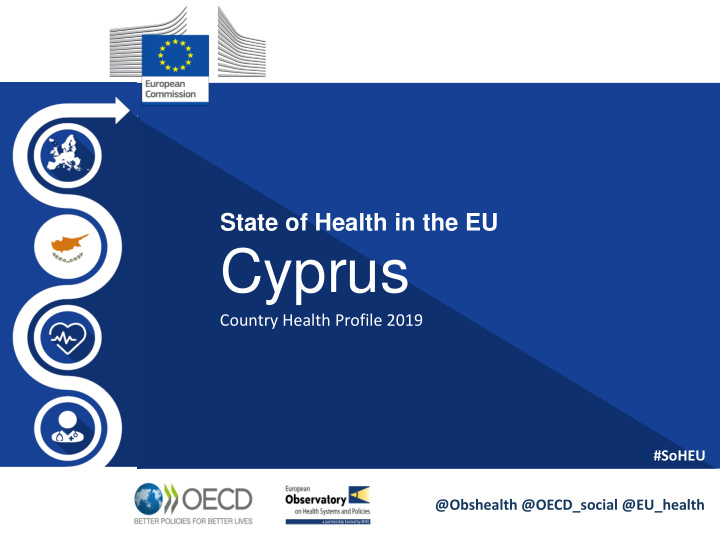



State of Health in the EU Cyprus Country Health Profile 2019 #SoHEU @Obshealth @OECD_social @EU_health
Profile outline 1 Highlights 2 Health status Risk factors 3 1 The health system 4 Health system performance 5 Key findings 6
2: Health status in Cyprus
Deaths from many diseases have decreased, with the stark exceptions 2 of Alzheimer’s disease and lung cancer
Just over half of people in Cyprus report having at least one chronic 2 disease after the age of 65 The share of people aged 65 Fewer Cypriots over 65 years and over has increased report that they experience steadily; in 2017 one in six limitations with basic activities Cypriots were over 65 and of daily living ( 12% this is expected to reach one compared with an EU in four by 2050 . average of 18% ).
3: Risk factors in Cyprus
Cyprus compares well with the EU on some risk factors, but smoking 3 remains a major public health problem Tobacco consumption is a major contribution to mortality – one in five deaths (21%) are tobacco-related In 2015-2017, among 6-9 year old boys and girls 20% were obese and 43% were overweight or obese.
The health system in Cyprus
Health care funding in Cyprus is characterised by low public spending 4 and high out-of-pocket payments • Private as a share of total spending is very high – 56.2% in 2017 (45% OOP, 11.6% VHI) • Despite increases, the share of government spending (6.7% GDP) is still far below the EU average (9.8% GDP)
Cyprus has been spending less per person on inpatient, outpatient and 4 long-term care compared to the EU • Cyprus spends less per person on all aspects of healthcare than the EU average • But 40% of spending goes to outpatient care (EU average is 29.7%), and 1% goes to prevention (EU average is 3.1%)
The number of doctors in Cyprus is above the EU average, while the 4 number of nurses is well below • Most doctors work in the private sector, while most nurses are in the public sector • Efforts to recruit additional GPs and paediatricians to work in the public system are underway
Health system performance in Cyprus
Effectiveness: Cyprus records the lowest rate of preventable mortality, 5 while mortality from treatable causes is also comparatively low Low preventable mortality rates might be explained in part by lower exposure to some risk factors
Accessibility: Very high out-of-pocket spending does not lead to high 5 catastrophic spending in Cyprus • Catastrophic spending is very low considering how high out-of-pocket spending is, potentially because the public sector services have been able to act as a safety net • Most OOP spending is on outpatient medical care and pharmaceuticals • High-cost diagnostics are mostly available in the private sector
Accessibility: Lower income groups in Cyprus have higher levels of 5 unmet needs for both medical and dental care Unmet needs for medical care are mainly due to long waiting times in the public sector. Unmet needs for dental care are mainly for financial reasons
Resilience: Day surgery rates are an indicator of efficient resource use, 5 and in Cyprus they are underdeveloped except for cataract surgery Saving money by improving efficiency in hospitals and strengthening primary care to support availability of more services in less costly and more appropriate settings are key to enhance health system resilience
Key findings for Cyprus
6 Summary of the key findings Cypriot people live long and Implementing the new General generally healthy lives . Mortality rates have fallen by over 20% but Healthcare System is the greatest challenge Cyprus faces to expand preventable deaths from lung cancer are among the highest in the coverage and improve financial equity. EU. More than a quarter of adults in Cyprus smoke Primary care is being strengthened to improve daily although binge drinking is lowest in the EU . Obesity coordination across private and and overweight among public providers through gatekeeping children it is now extremely high at 43%. Changes to the payment system for Out-of-pocket spending is inpatient care is designed to highest in the EU. Although rationalise reimbursement and Unmet needs for medical care improve resource used to ensure are low they are ten times higher the sustainability of the system for low-income groups .
ec.europa.eu/health/state oecd.org/health/health-systems/country-health-profiles-EU.htm euro.who.int/en/about-us/partners/observatory/publications/country-health-profiles
Recommend
More recommend